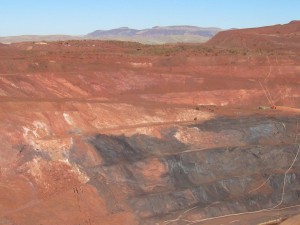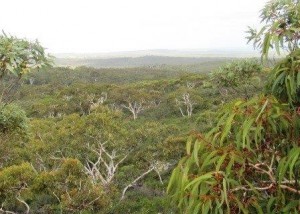Those of us who love the serenity and pristine nature of National Parks had better start linking arms. Governments in Australia are bending to the will of mining companies to allow mining and coal seam/shale gas projects, if not inside National Parks, then way too close for comfort.

Karajini National Park in the Pilbara region of Western Australia is surely one of the 10 natural wonders this country has to offer – and it sits alongside an enormous open cut iron ore mine. The WA State government excised the Rio Tinto-owned Marandoo Mine from the national park in 1992. The WA government bans mining in all but three national parks – one of which is Karajini.
Rio Tinto operates 15 iron ore mines in the Pilbara and has spent $880 million opening up new mines. Even the 50-year-old Tom Price mine is still operating and now processing ore from the nearby Western Turner Syncline. While Tom Price is a mining town, almost all of these new mines use the preferred method of flying workers in and out of mine sites.

After spending three days camping in the breathtakingly beautiful Karajini National Park, we drove past the Marandoo Mine, located in a narrow valley of the Hamersley Range, effectively splitting Karajini into north and south areas.
Next day, we took a tour of Rio Tinto’s open cut iron ore mine in Tom Price. You could not develop a mine like Tom Price today. Some of its pits, like the one pictured, are 500m deep and require constant pumping, as they fill up with ground water. Big mining towns like Kalgoorlie, Tom Price, Broken Hill and Mt Isa were discovered and developed long before such inconveniences as environmental impact statements, air quality monitoring and workplace health and safety procedures.
While Rio Tinto has become the industry leader in worker safety, mining is still very dangerous work. Safe Work Australia figures show that 70 people died in the mining industry between 2003-2004 and 2009-2010. In WA, the Department of Mines and Petroleum says 52 people were killed at work between 2000 and 2012, although the incidence has dropped since then. Despite the risks, the above-average wages and the work-hard play-hard environment is attractive to healthy young men and women eager to save for a deposit on their first home or build a career.
We spent half a day in Mandurah visiting relatives and were astonished by the rapid growth of what used to be a Perth satellite suburb and is now WA’s second-biggest city. It is crammed full of big, new houses where many of the Mums (and the occasional Dad) stay at home with the kids until Dad (or Mum), comes home for their days off from one of the FIFO mine sites.
The Tom Price mine started production in 1994 and Rio Tinto approved an expansion in 2011 that will extend the life of mine to 2030. The Hamersley Range is so full of iron ore you can never afford to say that the Marandoo excision was a one-off. Indeed, the hill behind the Karajini National Park information centre is of particular interest for its high iron ore content. Mines appear in all kinds of unexpected corners of the country. We headed down a dirt road toward Sandy Point, south of Geraldton, attracted by stories of a friendly, laid-back beachside campground with sparkling white sand, great fishing and safe swimming.
It was just as beautiful as we’d been told, but its immediate neighbours are two big sand mines. Sand dunes along the WA coast are exploited for their heavy mineral content – ilmenite, zircon, rutile and monazite.
Fracking comes to WA
The one thing I did not expect to see, driving along Western Australia’s Coral Coast via the Brand Highway, was a large sign denouncing the process of ‘fracking’. The 2-metre high neon sign simply says “Fracking Poisons Water”, a matter for debate, but in this instance serving as a “What’s going on around here?” prompt for motorists. (Fracking involves pumping high pressure water, sand and chemicals into subterranean rocks to release the gas trapped there).
What’s going on is that Sydney-based listed company AWE has made a significant new shale gas discovery in the Dongara/Wagina reservoir. Anyone familiar with the terrain along WA’s Coral Coast would realise that Dongara, south of Geraldton, is on the doorstep of Lesueur National Park.

Prior to our recent trip to WA, we were unaware of Lesueur National Park, a unique bio-diversity hotspot of some 27,000ha. It protects 900 different plant species, more than 10% of the flora of WA, and seven species of rare fauna. Lesueur, which is a must-do on the tourism wild flower trail, has already once been saved from the rapacious advances of the extractive industries.
In 1990 there was a rare meeting of minds between conservationists, lefties, righties, local land owners, fishermen and farmers to rebuff the mining/energy industries.
The Hill River Station proponents wanted a 2.5 million tonnes a year open cut coal mine and a 600MW power plant near Mount Lesueur, 25 kms from Jurien Bay and the Coral Coast.
The Environmental Protection Agency rejected the proposal as a result of overwhelming public protest and two years later the park was gazetted.
AWE has all but dismissed claims that its plan to exploit tight and shale gas reserves poses a threat to groundwater. The West Australian’s Daniel Mercer was invited to travel to the Senecio well site where AWE managing director Bruce Clement put his side of the story. He stated that horizontally-fractured wells found in WA’s mid-west were always at least 1.5 km deeper than aquifers and there is “invariably” an impermeable layer of rock between the gas and the water.
Conservation Council of WA director Piers Verstegen told the West Australian that if AWE was so comfortable with fracking it would have been more upfront in telling locals of its intentions. Land owners and environmentalists are concerned about the progress of drilling by AWE and others, given that a Parliamentary Inquiry into fracking is ongoing and unlikely to be completed this year.
The Green Left Weekly says if unconventional gas exploration and fracking is allowed on the border of Lesueur National Park, it would set a precedent that would allow fracking throughout the mid-west of WA.
Meanwhile, Queensland shuts the gate
It is probably worth pointing out that in Queensland, this kind of public support to oppose a mining proposal can no longer happen. A controversial new mining bill shuffled through Queensland Parliament last month (September), has restricted the right of appeal on “philosophical” grounds. The right to object is restricted to neighbouring property owners of the land to be mined, drilled or otherwise developed.
Understandably, the Lock the Gate Alliance does not think much of this new law, and the Greens are likewise upset.
You should be too. In theory, a drilling crew could set up at the end of your street and start looking for coal seam gas and only the people in the adjacent houses would have a right to object.
